Plan Drawing Deck Barges Structural Detail
Introduction
In the simplest terms, Transportation Assay is the complete design and engineering which goes backside making a transportation performance successful. In this post we'll talk about transportation of projection cargo over deck. Such cargo can be equipment, modules or other heavy construction (similar a jacket or a crane being transported). A visualization of the entire functioning appears quite unproblematic – identify the item on the deck of the vessel, move the vessel to its destination, and unload the item. However, depending on the size and geometry of the cargo, the whole functioning tin can involve deeper intricacies which require careful engineering calculations and analyses. In this article we breakdown the steps involved in doing a complete transportation assay. This may or may non exist applicable to all vessels or cargo, but it can give a fair idea to avoid common pitfalls of engineering during marine transportation.
Steps of Transportation

In general, the following steps are followed for whatsoever deck cargo transport:
- The Cargo is lying on quay side and is loaded to the vessel. This step is chosen 'loadout'
- Afterward loading on the vessel, the cargo has to be secured to the vessel. This step is chosen 'Seafastening'
- The vessel motions and stability during the voyage have to be pre-assessed
- Upon reaching the destination, information technology has to be loaded in from the vessel to the quay/port. This step is chosen 'load-in'
Earthworks deeper
If we dig deeper and call up more analytically, following are the questions which may go relevant for each step
- During Loadout/Load-in
- Is the vessel big enough to accommodate the cargo?
- Fifty-fifty if the vessel if large enough, is it stiff enough? Volition its deck be able to withstand the load of the cargo?
- How will the transfer from quay to vessel exist done? Will the cargo be lifted, will it be skidded or transferred using a SPMT trailer?
- Will the vessel stay stable during the loadout/load-in? How volition we ensure it is at even keel during the process?
- After Loadout from Quay to vessel
- How will the cargo be secured to the deck? Will it be lashed using ropes, or will it be welded to the deck?
- How many lashings to be used? How strong should the lashings exist?
- How to spread out the cargo load on the deck? What should exist the ideal location where the cargo legs should sit?
- During the transportation
- How to maintain the stability of the vessel during the transport?
- How will the cargo be afflicted by environmental forces of wind, wave and current? How to approximate how much load will come on to the cargo from these forces? How will they impact the design of the seafastening?
- How will the vessel move? Volition information technology apply its ain propulsion, or volition it exist towed? How to select the correct tug, if information technology is to be towed?
Breaking information technology downwardly
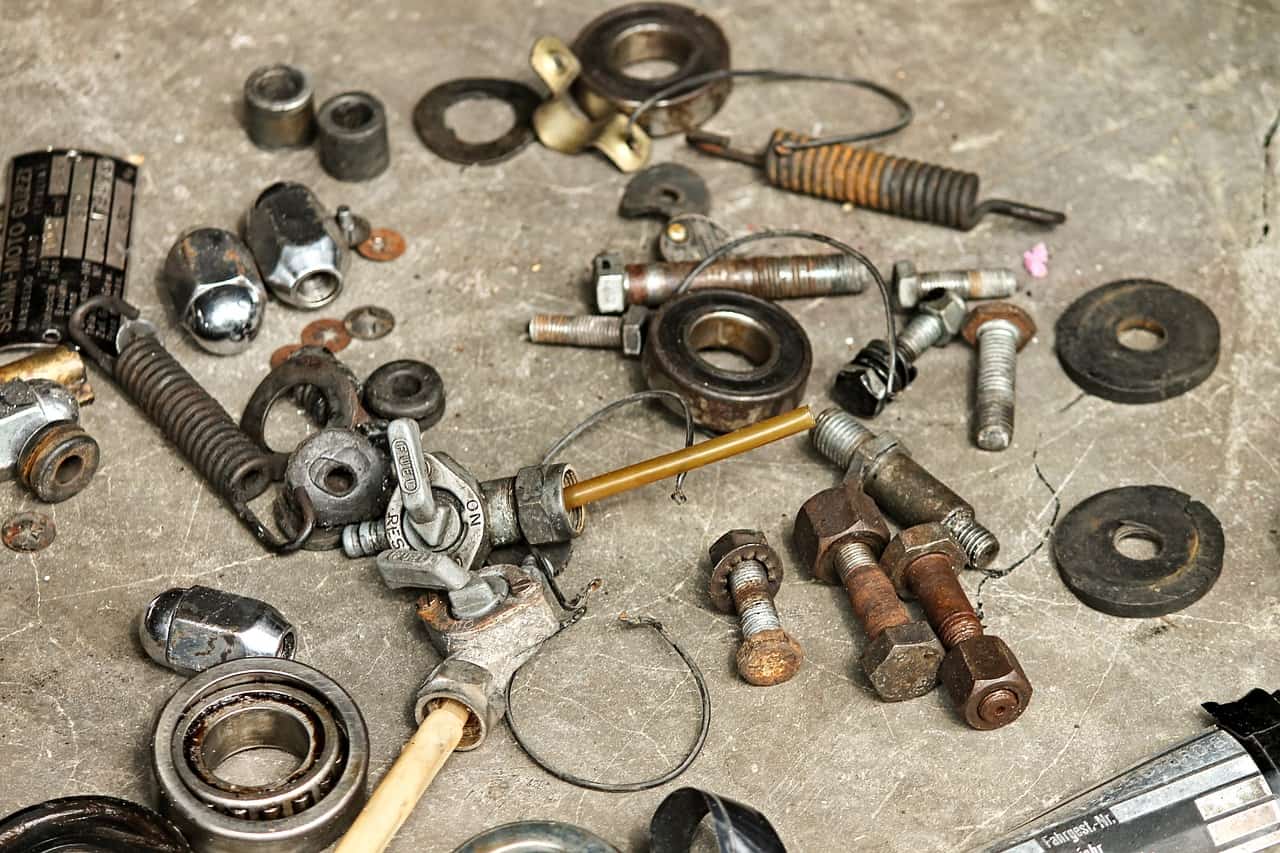
Hither we interruption downward the steps of engineering which are performed for a successful transportation operation. Again, not all of them may be applicable to all operations, and we tin can pick and cull depending on the complexity of the functioning.
Additionally, information technology should be noted that all these analyses and calculations must be performed much prior to the actual performance and passed on to the operations team and blessing authority (generally Marine Warranty Surveyor).
- Transport or tug-barge? Whether to apply a cocky-propelled ship or a tug-barge combination is mostly a commercial decision and taken at the very initial phase
- Infinite check – The vessel must accept clear deck infinite to suit cargo. However, that's not enough – the deck space should be sufficient to add together lashings to the cargo on the sides and ends. An initial await on the locations of lashing points on the cargo can give a good idea of the infinite needed for lashings
- Deck strength – A quick check to meet if the deck of the vessel is stiff enough can be made by looking at the vessel'due south specification canvas. The deck strength is specified in units of tons/1000ii. Given the weight of the cargo and its footprint on the deck, we can calculate the deck load due to the cargo. This deck load should be within the deck strength limit of the vessel. While this may non be a very good parameter to guess any point loads the vessel may feel, it is even so a good parameter to estimate the vessel'due south forcefulness sufficiency in vessel selection stage. For the terminal transportation analysis, a thorough assessment of the deck force (axle analysis or FEA if needed) must exist carried out
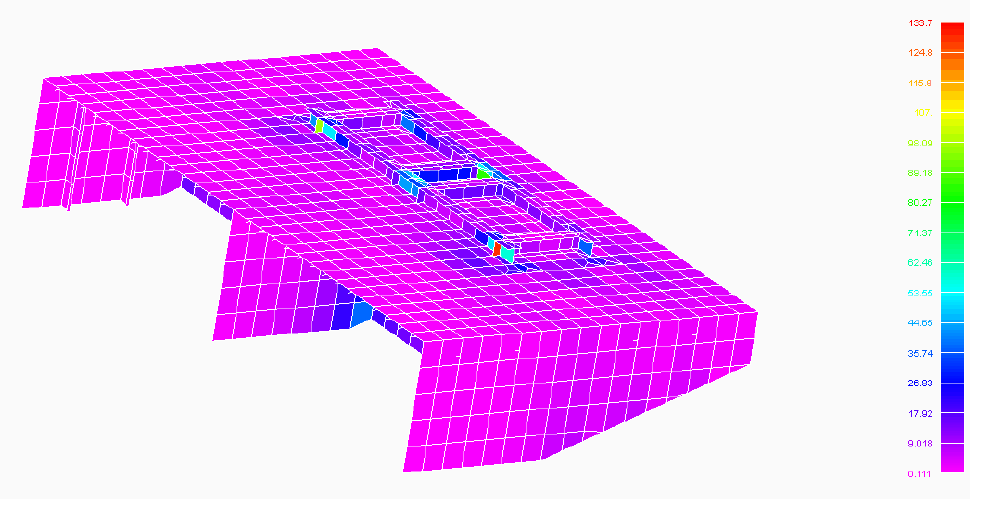
Iron Assay of a deck structure
- Loadout capability and strength : If the loadout is a lifted loadout, then the loadout operation is unproblematic and doesn't crave a detailed ballasting operation. For SPMT or skidded loadouts, the vessel must accept enough anchor capability to go through the disquisitional stages of loadout. More often than not, the most critical stage is when the whole cargo has simply lifted on to the vessel and is lying on the terminate where it has been loaded from. The tanks at the other end of the vessel must have plenty ballast capacity to keep the vessel on even keel. Also, the longitudinal strength of the vessel must stay within the limits. Generally, a spreadsheet solution for preliminary checks of vessel ballast capability can be developed for preliminary assessment. Yet, for heavier cargo, a software solution for hydrostatics and stability (like GHS/MOSES) must be used. For heavier Cargo, information technology should as well be noted that the foot of the cargo should sit on strong points like bulkheads to avert any strength issues. Once the vessel has been selected, a thorough assessment of its ballasting capability, stability and strength must be performed for each stage of loadout. However, generally Loadout is a split operation in itself and a dissever loadout written report is prepared. It is not generally included in the Transportation Analysis document. Pattern of loadout accessories similar the loadout ramp also forms role of this stage
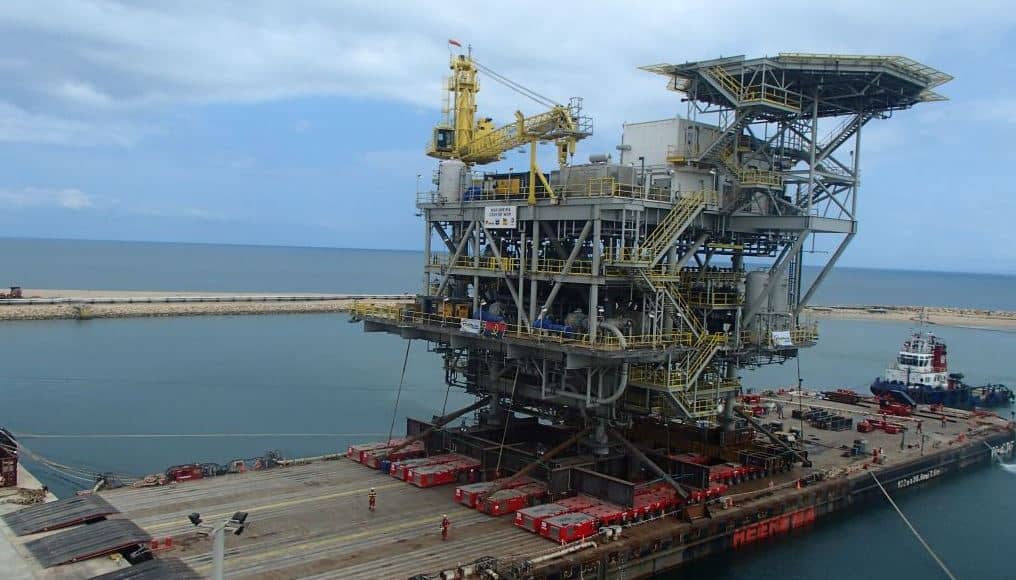
A loadout using SPMT trailer
- Transportation Stability: a cheque of the intact and damaged stability of the vessel during the transportation stage too needs to be performed. This may involve creating a 3D model of the vessel, performing detailed stability calculations using standard software and checking them against applicable Class rules
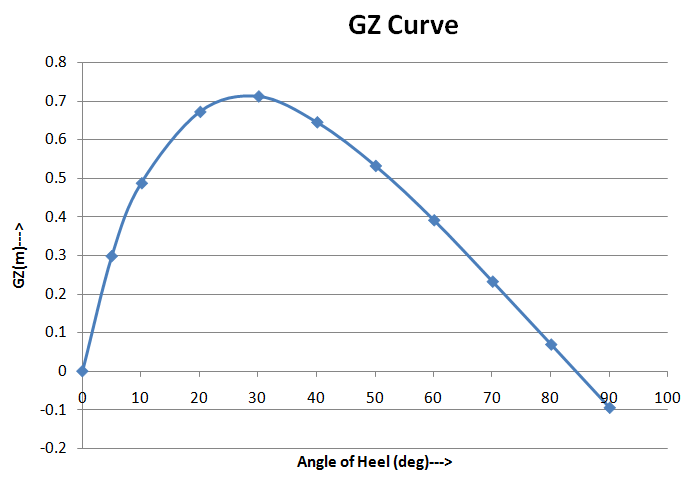
A typical Transport Stability Bend (a.g.a. GZ Curve or righting arm bend)
- Seakeeping/Motions analysis: To make up one's mind what kind of forces the cargo may feel during the transport (wind, wave, electric current), we may need to perform a complete seakeeping analysis, keeping in mind the worst sea country which the cargo may experience along the route. The environment information can exist obtained from nautical charts or metocean data. However, during the design or vessel choice stage, a conservative estimate can be made using a uncomplicated spreadsheet application post-obit standard guidelines like DNV-ST-Due north-001.
- Seafastening Blueprint: a detailed design of lashings may non exist required at the vessel selection stage, simply it will be a part of the transportation analysis. The lashing design volition involve pattern and specification of multiple lashing items:
- Lashing ropes or wires: Equally applicable, enough lashing ropes should be provided on sides and end of the cargo to restrain the cargo confronting the forces obtained from seakeeping assay. The complete specification of ropes/wires must be provided – length, size, type, stop type, material etc.
- Stoppers/clips/domestic dog-plates: Stoppers are used to restrain the translational motility of cargo. Clips/dog-plates are used to restrain the tipping of cargo. At times they my be used in conjunction with lashings
- Shackles and pad-eyes – Shackles must exist of sufficient strength to back up the lashings. Pad-eyes must be designed to be installed on deck and should be checked against whatsoever out-of-plane loads.
- Stanchions : If the cargo needs to be supported by stanchions on the side, the stanchions shall be of sufficient force. At times, a FE Analysis may be needed to affirm the suitability of stanchion.
- Dunnage : For cargo with small footprint, dunnages should be used to spread the load on the deck. Detailed bank check of dunnage strength should be performed to ascertain their size and suitability
- Wegdes, turnbuckles, rubber hoses – these are accessories of lashing ropes and should be provided in sufficient numbers.
- Lashing Program: A complete lashing plan drawing showing all lashing items must exist prepared and included in the Transportation Analysis document
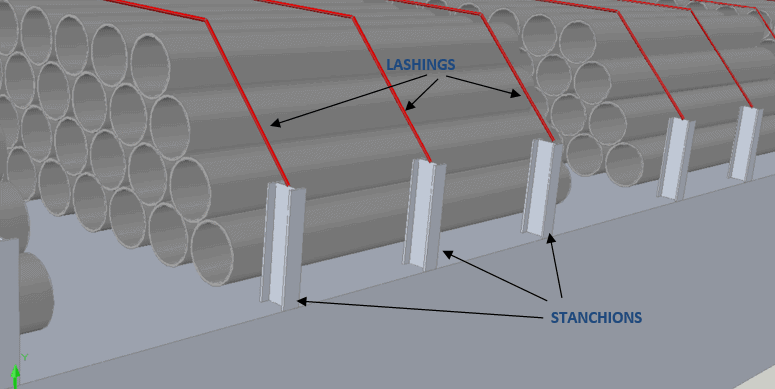
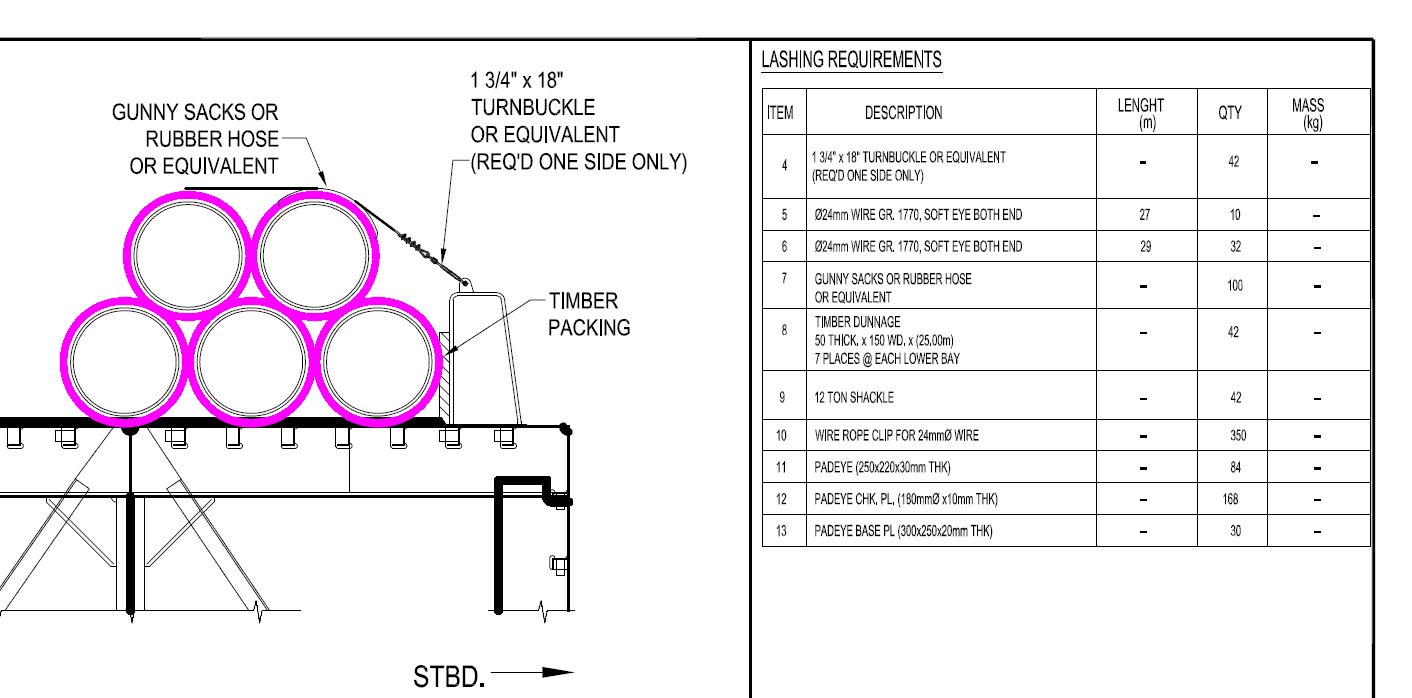
Typical lashing for transporting pipes
- Towing/Emergency towing arrangement: If the vessel is existence towed, a suitable tug has to exist selected for it. This will involve carrying out bollard pull calculations to select the tug. Besides, a towing arrangement programme may be needed detailing the complete towing bridle and its specifications required as per standard guidelines (DNV-ST-Northward-001). If the vessel is a Clomp, an emergency towing arrangement may also take to exist prepared and submitted equally office of the Transportation Analysis document.
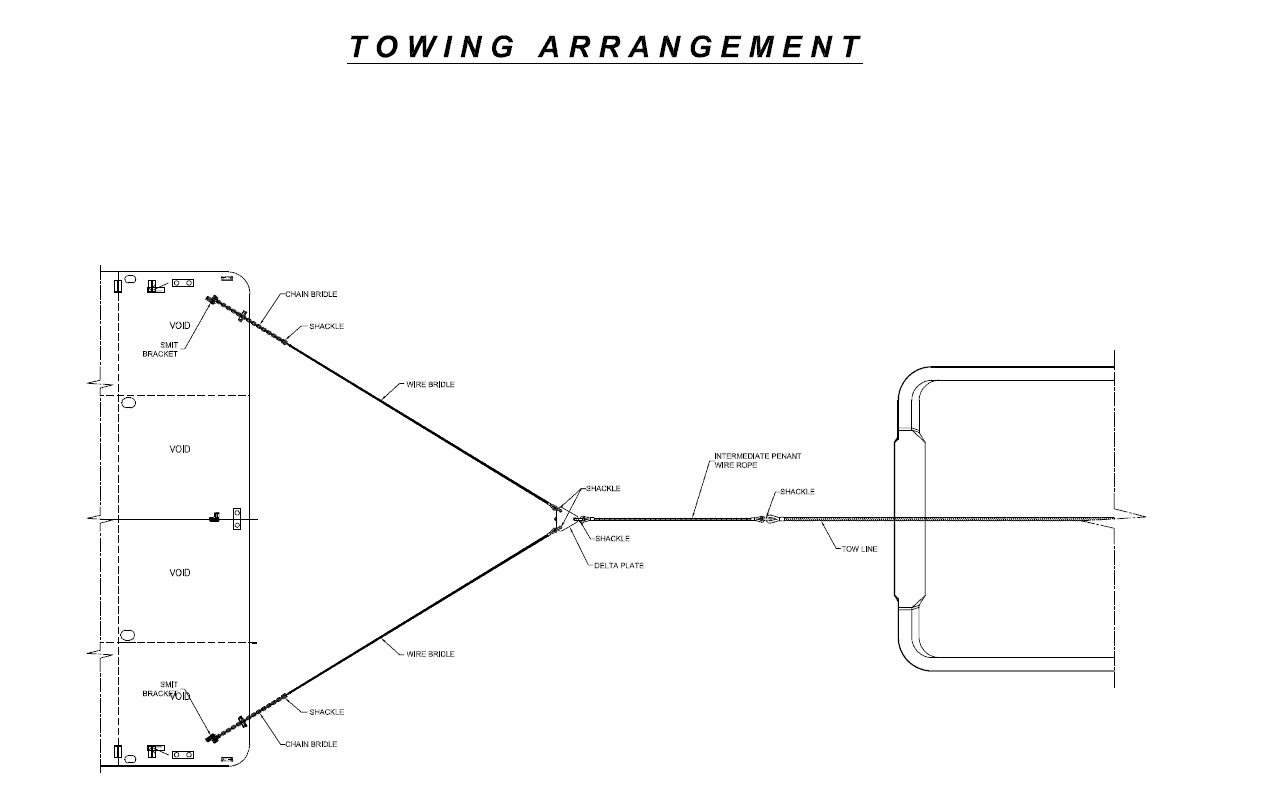
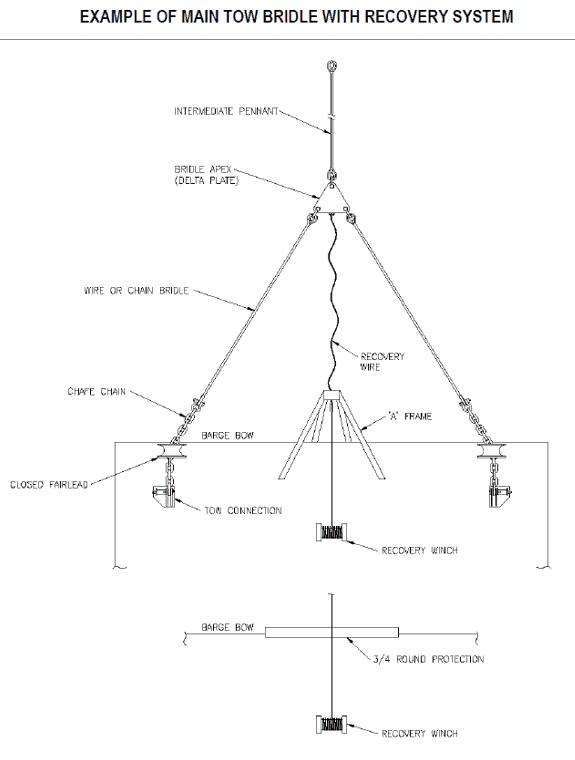
Typical Towing/Emergency Towing System (source: GL ND-0030 Rev 5)
Thus, we tin encounter that a complete Transportation Analysis involves multiple engineering calculations and analyses which have to exist performed diligently to ensure success of the functioning.
Now we list down the typical contents table of a Transportation Assay beneath. Delight note that loadout is not included, every bit it is by and large considered a separate operation with an contained analysis report. For each analysis performed, detailed results from software can be included in the Appendix of the report.
Transportation analysis: Typical tabular array of contents
- Introduction: project details and what cargo is being carried
- Vessel and cargo particulars
- Tow route particulars and surroundings data
- Stability analysis during ship
- Intact and damaged stability
- Longitudinal strength cheque
- Motility/Seakeeping analysis
- Deck Strength check
- Seafastening design
- Lashing design based on seakeeping results
- Lashing plan (drawing)
- Stanchion blueprint/check
- Pad-eye check
- Towing Organization blueprint (if applicable)
- Bollard Pull calculation
- Towing bridle pattern
- Towing and emergency towing arrangement program (drawing)
A thorough Transportation Analysis (TA) performed on fourth dimension for an operation is a great asset to the operations squad in planning and execution. While surprises are nearly always guaranteed during operations, a comprehensive TA serves equally a solid reference to manage them effectively.
Disclaimer:
This postal service is non meant to be an authoritative writing on the topic presented. thenavalarch bears no responsibility for the accuracy of this article, or for any incidents/losses arising due to the employ of the information in this article in whatever operation. It is recommended to seek professional advice before executing whatsoever activity which draws on data mentioned in this post. All the figures, drawings and pictures are property of thenavalarch except where indicated, and may not be copied or distributed without permission. The views, information, or opinions expressed in the article are solely those of the author and do not necessarily represent those of TheNavalArch Pte Ltd and its employees
Source: https://thenavalarch.com/transportation-analysis-for-deck-cargo-complete-breakdown/

0 Response to "Plan Drawing Deck Barges Structural Detail"
Postar um comentário